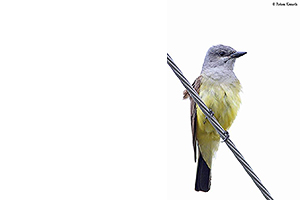 |
Western Kingbird
Tyrannus verticalis |
|
STANFORD LOCATIONS: Uncommon migrant and rare summer resident at the Dish, fairly rare elsewhere on campus. Most common in spring, but occasionally a pair will linger to nest at the Dish. Feeds on insects while making long sallies over open fields. |
 |
Location |
Type |
Mating System |
Parental Care |
2ndary Diet |
Strategy |
|
|
|
|
I: 18-19 DAYS ALTRICIAL |
|
|
|
15 feet - 30 feet (5 feet - 40 feet) |
|
(3-7) MONOG |
MF |
|
POUNCE |
| BREEDING: | Savanna, dry open country, agricultural lands, riparian woodland. ? broods. |
| DISPLAYS: | Male performs frenetic courtship flight, darting into air, fluttering, vibrating feathers, and trilling. |
| NEST: | Usu on horizontal branch against or near trunk of tree or on human-built structure; of variable materials, thickly and finely lined with hair, cotton, plant down. |
| EGGS: | White, creamy, pinkish, mottled with browns, gray, lavender, occ concentrated at large end. 1.0" (24 mm). |
| DIET: | Insects and berries. |
| CONSERVATION: | Winters from s Mexico s (except Yucatan) to s w Costa Rica. Rare cowbird host. Range has expanded since 1900 as suitable nest sites became available due to expanding agriculture. |
| NOTES: | Reproductive success varies with insect abundance; when insects abundant, clutches are larger and initiated earlier, nestlings are fed more often and grow faster. On territory very aggressive toward crows, hawks, etc. |
| ESSAYS: | Passerines and Songbirds; Bills; Masterbuilders; Range Expansion. |
| REFERENCES: | Blancher and Robertson, 1984, 1987; MacKenzie and Sealy, 1981. |
| Help | Abbreviations | Species-Alphabetical | Species-Taxonomic | Essays-Alphabetical | |
| Except for Stanford Locations, the material in this species treatment is taken, with permission, from The Birder's Handbook (Paul Ehrlich, David Dobkin, & Darryl Wheye, Simon & Schuster, NY. 1988). | |||||